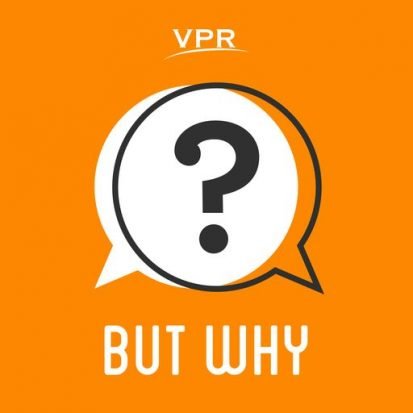
How much does the moon weigh?
Leave a reviewWe’re bringing back an episode from the archives, all about the moon: Why does the moon change shape? How much does it weigh? What color is it? Why does the Earth only have one moon? Why does it have holes? Where does it go when we can’t see it? Why do we sometimes see it in the daytime? And why does the moon look like it’s following you when you’re in the car? Answers to your moon questions with John O’Meara, chief scientist at the W.M. Keck Observatory.
© Vermont Public Radio | 20:10
|Episode: 176 |
Full episode description
 Episode One: But Why: Intro For Adults
Episode One: But Why: Intro For Adults
This is an Episodic show. You can listen to it in any order, but episode one is always a great place to start.Full Episode description
We’re bringing back an episode from the archives, all about the moon: Why does the moon change shape? How much does it weigh? What color is it? Why does the Earth only have one moon? Why does it have holes? Where does it go when we can’t see it? Why do we sometimes see it in the daytime? And why does the moon look like it’s following you when you’re in the car? Answers to your moon questions with John O’Meara, chief scientist at the W.M. Keck Observatory.
Download our learning guides: PDF | Google Slide | Transcript | Coloring Page
We can see the moon during the day for the same reason we see the moon at night. The surface of the moon is reflecting the sun’s light into our eyes. But we don’t see the moon all the time during the day, and that’s because of where the moon might be in the sky. There are times where the moon is on the other side of the earth so we can’t see it. We see the moon in the sky when it’s in the right spot and it’s reflecting enough light to be brighter than the background of the sky.
The moon is a satellite. A satellite is something that moves or rotates around a planet, the earth in this case. The moon is 239,000 miles away. That’s far, but it’s way closer than any of the other stars or planets you can see in the night sky. That’s why the moon looks so big compared to other celestial objects even though the stars are actually much bigger.
The moon weighs 100,000,000,000,000,000,000,000 pounds. That’s a lot! But it’s such a big number it’s hard to imagine how much that weighs. Instead, think about how much the moon weighs compared to the Earth. It turns out that the moon is about 1% percent the mass of the earth. That’s a lot!
When you’re in a car and it feels like the moon is following you, what you’re actually seeing is an optical illusion. The moon is very far away, compared to anything else you see when you’re driving — like the telephone poles that appear to fly past your car as you’re going down a highway. But the moon is so far away that its size and shape in the sky doesn’t change, so it feels like the moon is following you.
© Vermont Public Radiobop| Status: Active, 259 episodes | Kind: Episodic | Episode URL
The content, Artwork and advertising within this podcast is not owned or affiliated with Sound Carrot and remain the property of their respective owners.








